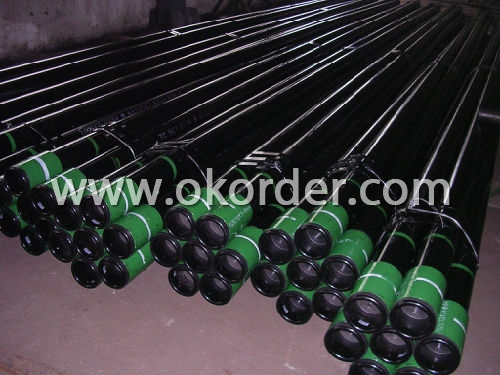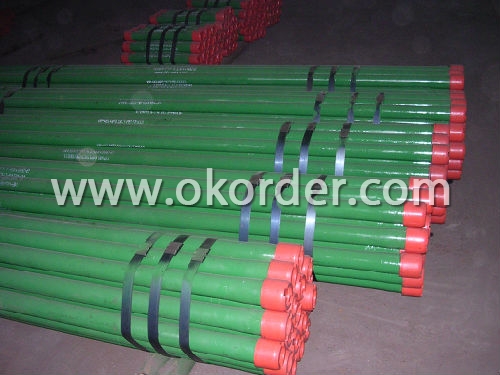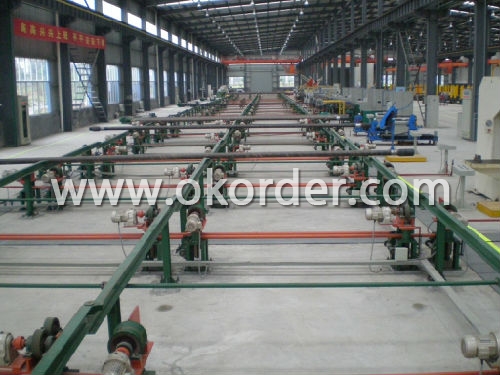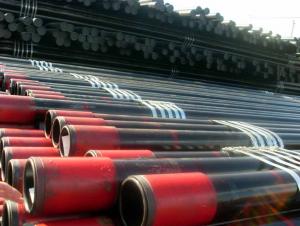API 5CT Oil Casing and Casing Pipe
- Loading Port:
- China Main Port
- Payment Terms:
- TT or LC
- Min Order Qty:
- Negotiable m.t.
- Supply Capability:
- 5000 Tons Per Month m.t./month
OKorder Service Pledge
OKorder Financial Service
You Might Also Like
Quick details of API 5CT Oil Casing andTubing
1.Thickness:5-60mm 2.Sction shape: Round
3.Outside diameter:4''-14''inch 4.Application: gas pipe,oil pipe
5.Size:SCH40-SCH160 6.Ending:plained or bevelled.
7.Deliver details:30-60 days. 8. Grade:10#,20#,16Mn,A53(A,B),A106(B,C),API J55,API P110
Item | Material | standard | specification (OD*WT)mm | application |
Alloy pipe | Cr5Mo. (P5,STFA25T5) 15CrMo (P11/P12/STFA22) 13CrMo44 12Cr1MoV P22 T91,P91,P9, T9 Wb36
|
GB5310-95 GB9948-88 ASTMA335/A335M ASTMA213/213M DIN17175-79 JISG3467-88 JISG3458-88 |
16-824*2-100 | high pressure,high/low temperature and is used in the industries of petroleum, chemical engineering and electric power as well as boiler |
High-pressure boiler pipe |
20G,A106, ST 45 |
GB5310-95 ASTM A 106-99 DIN17175-79 |
14-630*2-80 | Temperature-resistant seamless stell pipe far high-pressure boiler |
High-pressure seamless pipe for petroleum cracking |
20, 12CrMo, 15CrMo |
GB9948-88 |
10-530*1.5-36 | Boiler pipe for refinery, heat-exchanging pipe, seamless steel pipe for pipeline |
High-pressure seamless pipes for fertilizer making equipment |
20, 16Mn, Q345 |
GB6479-2000 |
18-530*3-40 | Fertilizer making equipment and pipe line |
Low and medium-pressure boiler pipes |
10,20 |
GB3087-1999 |
10-530*2-40 | Over-heat pipe for low and medium pressure boiler, boiling water pipe, locomotive smoke pipe(big and small) |
Fluid pipe |
20, Q345 |
GB/T8163-1999 |
8-630*1.0-40 |
Fluid feeding |
Structural pipe |
20, Q345 10, 20,35,45, 16Mn,Q345B |
GB/T8162-1999 |
6-1020*1.5-100 |
For common structure |
Line pipe |
Gr.B |
API |
60-630*1.5-40 | Carrying gas, water or oil in the industries of petroleum and natural gas |
Hydraulic prop pipe | 27SiMn | GB/T17396-1998 | 70-377*9-40 | Hydraulic support and prop |
Ship pipe | 410 | GB/T5312-1999 | 14-426*1.5-45 | Pipes for ship, boiler and over-heater |
Packing Details

Packing details

Production line

- Q:Can galvanized pipe be welded with seamless steel tube? What should I do to connect?
- To look at the use of concrete after welding, if the stress is relatively large and thin galvanized pipe wall is recommended to not use welding, if the requirement is not high Po mouth welding should be welding depends on galvanized pipe material selection electrode generally no sealing material are 20
- Q:What are the different methods of pipe coating for steel pipes?
- Steel pipes can be coated using various methods, each with its own benefits and uses. One widely used technique is fusion bonded epoxy (FBE) coating. This involves heating the steel pipe and applying a thermosetting powder that melts and sticks to the surface, resulting in a robust and long-lasting coating. FBE coating is excellent for preventing corrosion and is commonly employed in the oil and gas industry. Another method is liquid epoxy coating, where a liquid epoxy resin is applied to the steel pipe's surface. Once it cures, it forms a protective barrier. Liquid epoxy coating is suitable for smaller pipes and provides good resistance to chemicals. Polyethylene (PE) coating is a popular option, especially for pipes that will be buried underground. It involves wrapping the steel pipe with a layer of polyethylene, which offers exceptional resistance against water, chemicals, and abrasion. Polyurethane (PU) coating is another choice, known for its high chemical resistance and flexibility. It is often used in offshore applications and extreme temperature environments. Other pipe coating methods include coal tar enamel (CTE) coating, which provides excellent water and chemical resistance, and concrete weight coating, which adds weight to the pipe for stability in underwater or subsea applications. To summarize, the available methods for coating steel pipes include fusion bonded epoxy (FBE), liquid epoxy, polyethylene (PE), polyurethane (PU), coal tar enamel (CTE), and concrete weight coating. The selection of a coating method depends on specific requirements, such as corrosion protection, chemical resistance, or stability.
- Q:How are steel pipes used in the manufacturing of hydraulic systems?
- Steel pipes are commonly used in the manufacturing of hydraulic systems due to their strength, durability, and resistance to high pressure. These pipes act as conduits to transport hydraulic fluid, allowing the system to transfer power and control the movement of machinery. The steel pipes provide a reliable and leak-free connection, ensuring efficient and safe operation of the hydraulic system.
- Q:What are the different types of coatings used for steel pipes?
- There are several different types of coatings used for steel pipes, including epoxy coatings, polyethylene coatings, coal tar enamel coatings, and zinc coatings.
- Q:How are steel pipes protected against lightning strikes?
- Steel pipes are typically protected against lightning strikes through the use of lightning rods and grounding systems. These measures help to divert the electrical energy from a lightning strike away from the steel pipes, preventing damage or potential accidents.
- Q:Can steel pipes be used for geothermal heating systems?
- Yes, steel pipes can be used for geothermal heating systems. Steel pipes are commonly used for their durability and ability to withstand high temperatures and pressures. They are suitable for transferring geothermal heat from the ground to the heating system within a building. However, it is important to consider the specific requirements of the geothermal system and consult with professionals to ensure proper installation and compatibility with the system components.
- Q:Are steel pipes suitable for use in food processing industries?
- Yes, steel pipes are suitable for use in food processing industries. Steel pipes are known for their durability, strength, and resistance to corrosion, making them ideal for handling food products. They are also easy to clean and maintain, ensuring proper hygiene standards in the food processing industry. Additionally, steel pipes are capable of withstanding high temperatures and pressures, making them suitable for various food processing applications such as transporting liquids, gases, and solids.
- Q:What is the lifespan of galvanized steel pipes?
- The lifespan of galvanized steel pipes can vary depending on various factors such as the quality of the galvanization, the environment in which they are installed, and the maintenance they receive. However, on average, galvanized steel pipes can last between 40 to 70 years.
- Q:How are steel pipes used in the construction of airports?
- Steel pipes are used in the construction of airports for various purposes such as drainage systems, fuel pipelines, water supply networks, and structural support for buildings and runways.
- Q:How do you calculate the buoyancy of submerged steel pipes?
- To calculate the buoyancy of submerged steel pipes, you need to consider the principle of Archimedes' buoyancy. This principle states that the buoyant force acting on an object submerged in a fluid is equal to the weight of the fluid displaced by the object. To calculate the buoyant force, you need to determine the volume of the fluid displaced by the submerged steel pipe. The volume can be calculated by multiplying the cross-sectional area of the pipe by the length of the submerged portion. Next, you need to determine the density of the fluid in which the steel pipe is submerged. This can be obtained from the fluid's properties or by referring to known values. Once you have the volume and density of the fluid, you can determine the weight of the fluid displaced by the submerged pipe using the equation: weight = volume × density × acceleration due to gravity. Finally, the buoyant force can be calculated by multiplying the weight of the displaced fluid by the acceleration due to gravity. This will give you the upward force exerted on the submerged steel pipe by the fluid. It is important to note that in order to accurately calculate the buoyancy of submerged steel pipes, you should also consider any additional factors such as the weight of the pipe itself, any attached equipment or coatings, and the specific conditions of the fluid in which it is submerged.
1. Manufacturer Overview |
|
|---|---|
| Location | Shanghai China |
| Year Established | 1999 |
| Annual Output Value | Above Thirty Million RMB |
| Main Markets | Main land;Middle East; Southeast Asia |
| Company Certifications | ISO 9001:2010;API 5L |
2. Manufacturer Certificates |
|
|---|---|
| a) Certification Name | |
| Range | |
| Reference | |
| Validity Period | |
3. Manufacturer Capability |
|
|---|---|
| a)Trade Capacity | |
| Nearest Port | Baoshan |
| Export Percentage | 41% - 50% |
| No.of Employees in Trade Department | 300-500 People |
| Language Spoken: | English; Chinese |
| b)Factory Information | |
| Factory Size: | 30,000 square meters |
| No. of Production Lines | Above 10 |
| Contract Manufacturing | OEM Service Offered; Design Service Offered |
| Product Price Range | Average |
Send your message to us
API 5CT Oil Casing and Casing Pipe
- Loading Port:
- China Main Port
- Payment Terms:
- TT or LC
- Min Order Qty:
- Negotiable m.t.
- Supply Capability:
- 5000 Tons Per Month m.t./month
OKorder Service Pledge
OKorder Financial Service
Similar products
New products
Hot products
Related keywords































